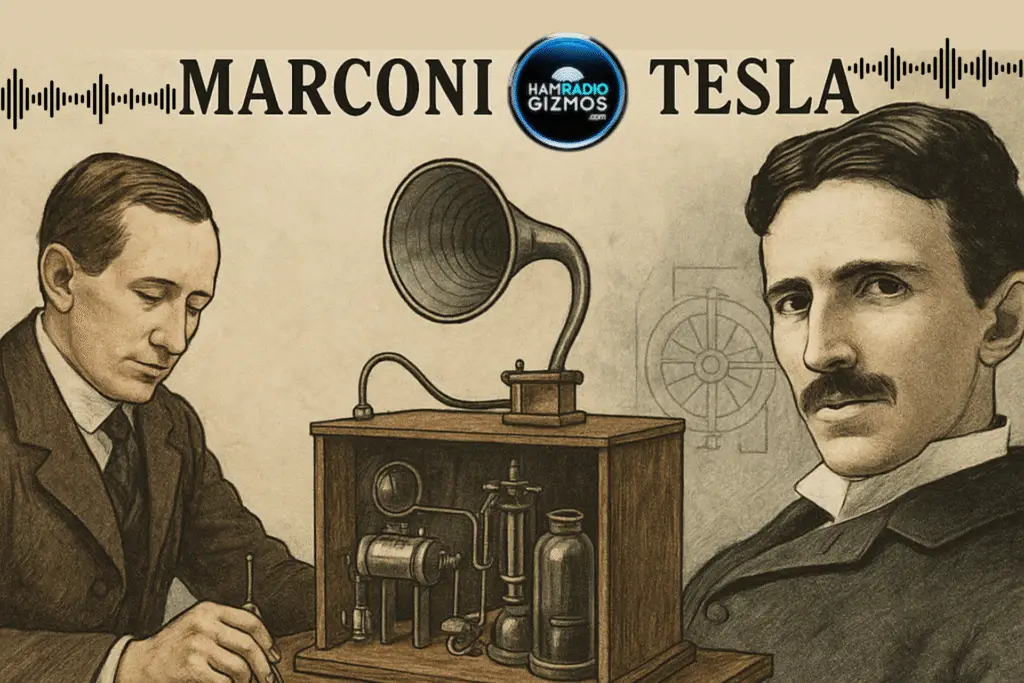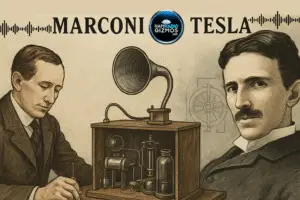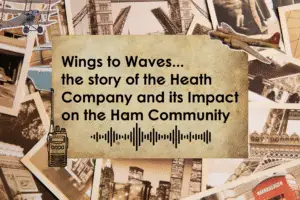
A mad scientist and a savvy businessman walk into a bar… haha, just kidding, but this line is a great opening for the Tesla vs. Marconi saga in the quest for wireless radio wave transmission.
So, who really was the inventor of radio, and who owns the patent? That’s exactly what we set out to learn in Ham Radio Gizmo’s video to uncover the story and grab some answers for you about the discovery of radio, who it’s attributed to, and why.
Thanks to our super-fab viewers, we learned that there continues to be speculation about the true origins of radio technology and its earliest innovators.
Still, the Tesla vs. Marconi tale is an interesting one to tell to help us understand the history of radio. Plus, it gives a glimpse of how things transpired in our revolutionary past, especially around innovation, new technology, business models, and intellectual property. It’s quite enlightening.
Besides, radio technology did lead to a whole bunch of fun discoveries for many, many years for Ham Radio lovers the world over! But, back to the feud at hand…
Marconi vs. Tesla: Patents Filed
You may find it surprising to hear that Tesla was the first to file a patent; however, Marconi held it— and made a bucket ton of money off it nonetheless— for a long time.
Let’s rewind to the late 1800s. Electric lights were wild enough, but TESLA, the showman genius, was dreaming bigger: WIRELESS energy and communication were dancing in his head. In 1891, Tesla invented the Tesla coil—glorious electric arcs for his demos, yes— but crucial for generating radio waves and experimenting with wireless energy. It’s still used in radio tech today!
By 1893, Nikola Tesla publicly displayed his wireless signal transmission with tuned resonant circuits, matching frequencies, and transmitting info without wires. He even sketched out the blueprint for GLOBAL wireless. Wow, right?
Beyond these lectures and demos in St. Louis, Tesla by 1897 had filed radio transmission (US) patents detailing:
-
- Transmission of electrical energy wirelessly
-
- Concept of matching transmitter and receiver frequencies
Initially, the U.S. Patent Office rejected many of Marconi’s U.S. filings, pointing to Tesla’s 645,576/649,621 as prior art, even calling Tesla’s “oscillator” a household name. Despite this, in a surprising 1904 reversal, the USPTO granted Marconi a radio patent in the U.S. Tesla was dismayed by this, and quipped to an associate, “Marconi is a good fellow…he is using seventeen of my patents.”
But sometimes (as you know) it’s not what you know but who you know. So, despite the earlier filings of Tesla, but also by names like Lodge and Stone, Marconi prevailed. At least for the entirety of Tesla’s life.
Backed by the British aristocracy and powerful and influential individuals like Edison and Carnegie, Marconi had helpers. However, J.P. Morgan pulled Tesla’s much-needed funding, making things even more dire for Tesla and his genius work.
The Battle Between Nikola Tesla & Guglielmo Marconi Fizzles
Meanwhile, the accolades and rapid adoption of Marconi’s wireless system in maritime, military, and communication networks led to a Nobel Prize win in 1909.
Tesla sued Marconi’s company in 1915 for infringement, but lacked the resources to continue, so nothing was resolved.
Finally, after Tesla died in 1943, the U.S. Supreme Court faced Marconi Wireless Corp. vs. USA (for wartime royalties). The Court ultimately invalidated Marconi’s broad tuning patent claims as already anticipated by earlier inventors (John Stone, Lodge, and Tesla). Tesla’s patents were reinstated, technically naming him the inventor of radio.
Despite a lack of recognition and money at his death, Tesla and his role in radio are celebrated in recent decades with Tesla Day Remembrance. However, most historians credit Marconi with radio’s practical implementation. The controversy reminds me of the “chicken and egg syndrome,” in a way.
But perhaps the lesson is more. The contrast in approach with Tesla’s grand, visionary ideas, often unrealized, and Marconi’s focus on practical, commercial development may have been the perfect spark for a dream team for radio innovation and tech, with powerful business clout wired in!
Instead, it feels a little more like winners and losers. Maybe it’s a great reminder that everyone has something to contribute. And, you know, the sum of the whole is greater than its parts… something like that…
Further Contributors to the Radio Wave
Heinrich Hertz gave the concept its experimental life in the 1880s. Oliver Lodge and Édouard Branly enabled detectors (coherers) to convert waves to signals. Reginald Fessenden (Canada/US) later pioneered voice broadcasting (1906), and Lee de Forest invented the triode tube (1906) to amplify radio – all of these building on the Tesla/Marconi groundwork.
Hertz, Lodge, and Stone may have contributions preceding or aligning with those of the rival two. But again, more heads, even radio heads, allow for a bigger combined result. All were integral to the revolutionary changes of the times, and we still benefit from them today.
by: Sue-Ann Bubacz


